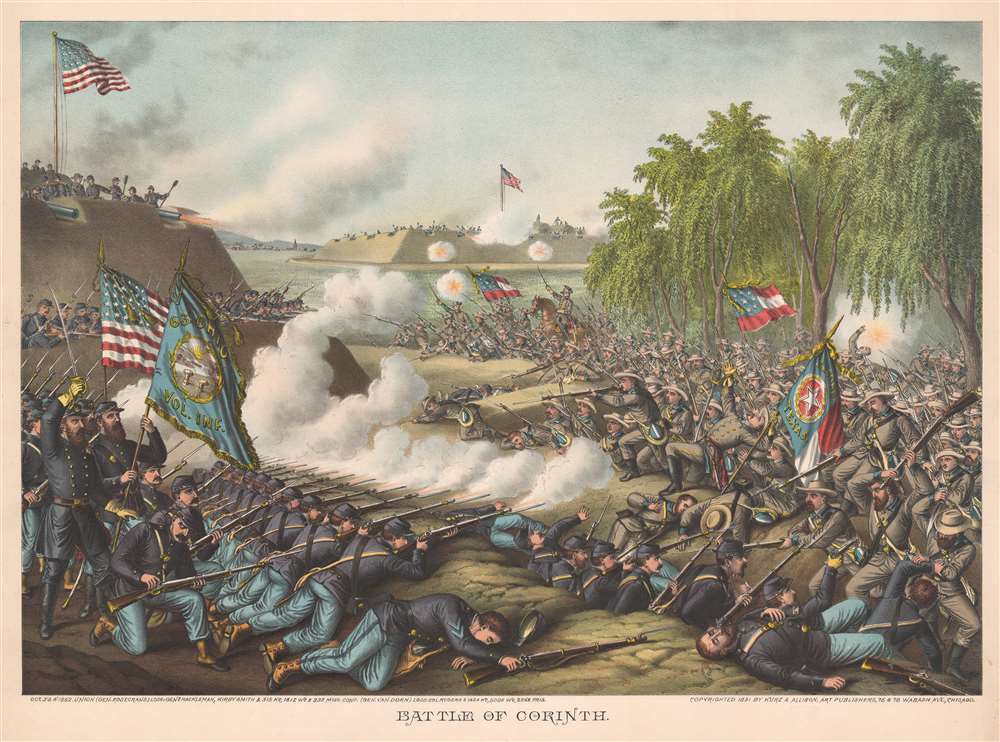This item has been sold, but you can get on the Waitlist to be notified if another example becomes available, or purchase a digital scan.
1891 Kurz and Allison View of the American Civil War Battle of Corinth, Mississippi
BattleCorinth-kurzallison-1891
Title
1891 (dated) 18.5 x 25.25 in (46.99 x 64.135 cm)
Description
The Second Texas Infantry Regiment at Corinth
Colonel William P. Rogers, commanding officer of the 2nd Texas, was killed during the charge. It is said that he had his horse shot out from under him and, almost at that same moment, the regimental flag bearer was shot and killed. Rogers grabbed the flag and continued the assault, leading his men up the battery's ramparts. He was shot during this charge, making him the fifth color bearer for his regiment to be killed that day outside Corinth.The Battle of Corinth
The Battle of Corinth took place on October 3 - 4, 1862, in and around Corinth, Mississippi. Union forces, led by Major General William Rosecrans, were entrenched in Corinth awaiting an attack by Confederate Major General Earl Van Dorn. Van Dorn's objective was to seize Corinth and then proceed north into Tennessee to help Confederate General Braxton Bragg in his push north into Kentucky. Van Dorn's forces saw success on the first day of battle, driving Union forces from their thinly manned first line of defense back to their more easily defended second line, which included three gun batteries. On the second day, Van Dorn's men achieved limited successes, but Rosecrans's army either turned back or recaptured every objective Van Dorn seized over the course of the day. Due to heavy losses and having not achieved his objective of driving the Union Army out of Corinth, Van Dorn retreated on the afternoon of October 4.Kurz and Allison Civil War Lithographs
The publishing firm Kurz and Allison created a series of thirty-six battle scenes from the American Civil War in the late 1880s and early 1890s. At the time of their publication, historical interest in Civil War was at an all-time high, with many of the participants still alive and heroes to the subsequent generation. Kurz and Allison's views, due to their high production quality, were the most popular series of Civil War views ever published. In a style reminiscent of Currier and Ives, the chromolithographs were not meant to be purely historical representations, and from time to time, included historical inaccuracies. Even so, 'prints depicting the Civil War battles by Kurz and Allison are among the most sought-after collectibles of Civil War enthusiasts.'Chromolithography
Chromolithography is a color lithographic technique developed in the mid-19th century. The process involved using multiple lithographic stones, one for each color, to yield a rich composite effect. Oftentimes, the process would start with a black basecoat upon which subsequent colors were layered. Some chromolithographs used 30 or more separate lithographic stones to achieve the desired effect. Chromolithograph color could also be effectively blended for even more dramatic results. The process became extremely popular in the late 19th and early 20th centuries, when it emerged as the dominate method of color printing. The vivid color chromolithography produced made it exceptionally effective for advertising and propaganda imagery.Publication History and Census
This view was created and published by Kurz and Allison in 1891. We note only two cataloged examples which are part of the collections at the Library of Congress and the Metropolitan Museum of Art. This print appears occasionally on the private market.Cartographer
Kurz and Allison (1880 - c. 1905) was an American publishing firm known for its chromolithographs. Founded by Louis Kurz (1835 - 1921) and Alexander Allison, the firm was based at 267-269 Wabash Avenue in Chicago. In the partnership, it is known that Kurz, an Austrian immigrant, was the lithographer and it is presumed that Allison provided the financial backing. The firm is most well-known for its series of thirty-six battle scenes from the American Civil War. At the time of their publication, the late 1880s and early 1890s, a general nostalgia was prevalent among Civil War veterans (of which Kurz was one), and evidently the company was trying to capitalize on the sentiment. Kurz and Allison's Civil War prints were not the first such prints to be issued, but they were by far the most popular. In a style reminiscent of Currier and Ives, Kurz and Allison lithographs are not meant to be historical representations, and even, from time to time, included historical inaccuracies. Even so, 'prints depicting the Civil War battles by Kurz and Allison are among the most sought-after collectibles of Civil War enthusiasts.' Their prints are also notable for featuring African-American soldiers, a rarity for the era. After the outbreak of the Spanish-American War, the firm published views from famous battles and continued doing so for the campaigns of the Philippine-American War and the Russo-Japanese War. More by this mapmaker...

